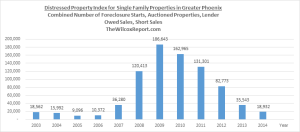February 2015 Results
Signs and numbers point to a heated housing market in Phoenix this spring
Purchases with a mortgage are increasing – decreasing are new monthly listings
February 2015 purchases with a mortgage were the highest for a month of February since February 2006
5,945 less new monthly listings for the last nine months year-to-year
Changes coming to residential real estate closing process starting on August 1, 2015. See page seven.
Sales in which a buyer purchased with a mortgage in February 2015 were 15% higher than February 2014. February 2015 purchases with a mortgage were the highest for a month of February since 2006, which was before the great real estate recession. Is the February 2015 increase in mortgage purchases a sign that demand to own is growing? Maybe. There are some other recent signs. Mike Orr Director of the Center for Real Estate Theory and Practice at the W. P. Carey School of Business at Arizona State University said that “During February it became clear that from watching contract rates that the market was starting to take off.” Philip Haldiman from the Rose Law Group Reporter wrote that people are camping out to buy homes at a Mesa subdivision. The subdivision is the new Mulberry Community, by builder Blandford Homes. Purchase prices start in the low $200,000 and range from 1,700 to 4,300-square feet. Watch this video from Catherine Reagor Arizona Republic reporter on once again camping out for new homes.
More signs and numbers pointing to an increase in purchases with a mortgage Increasing are job growth, and population growth, and boomerang buyers. While job growth and population growth are lower than their historic norm, and could be better, both are growing. At the same time job and population numbers grow, growing is the number of possible boomerang buyers. These three factors should contribute to an increase in mortgage purchases.
Increasing job growth. You have to have a job to get a loan. Greater Phoenix lost 302,100 non-farm jobs from December 2007 to July 2010 (December 2007 is the record month for most non-farm jobs, while July 2010 was the month with the least non-farm jobs since the start of the great real estate recession). Greater Phoenix has gained back 266,500 jobs from July 2010 to December 2014. From December 2014 to December 2015, jobs should grow by another 50,000.
Increasing population growth. The population grew by approximately 46,000 in 2014 over 2013. 2015 population growth is projected to increase by 57,000 over 2014. And from 2015 through 2020 projections are 327,800 more people. More people means more housing.
Increasing Boomerang Buyers: A boomerang buyer is defined as someone who buys after going through a foreclosure or short sale. As time goes on, more and more people will have reached the minimum wait periods or penalty boxes for being able to buy again with an FHA, Fannie Mae or Freddie Mac loan. I estimate that from 2009 through 2014, 220,536 homeowners that were owner occupants, not investors, either went through a foreclosure or short sale. The minimum wait period to buy again after a foreclosure or short sale is three years with an FHA insured loan; four years after a short sale with a Fannie Mae or Freddie Mac loan; and seven years after a foreclosure to purchase with a Fannie Mae or Freddie Mac loan. As time goes on, more and more people will meet the required wait periods, and if they have the necessary credit score, down payment, and closing costs they will be able to purchase with a mortgage. Let’s hope there will be enough inventory for them.
New Monthly Inventory of Single Family Homes June of 2014 was the first month last year, to have less new monthly listings when compared to the same month of the previous year. February 2015 was the ninth consecutive month year-to-year, that there were less new monthly listings, resulting in 5,945 less listings.
Sales by sold price range, median sale price, total volume The sold price range with the largest increase in sales year-to-year was between $200,000 and $249,999 with 185 more sales. The sold price range with highest year-to-year increase in percentage was between $300,000 and $349,999 with a 34% increase. There were thirteen more sales over $1,000,000 for an 18% increase. The February 2015 median sale price was $220,000 or $10,000 higher than February 2014. Total sales volume was $101,569,653 higher.
On August 1, 2015 new rules apply to most closed-end consumer mortgages. The rules effect existing and new home purchases, refinances, loans secured by vacant land, construction only loans, and timeshare loans. Excluded are reverse mortgages, home equity lines of credit, mortgages secured by a mobile home or a dwelling that is not attached to real property. The Consumer Financial Protection Bureau or the CFPB a creation of the Dodd-Frank Act, has integrated mortgage disclosures and created new forms. For loans originated on August 1, 2015 or later, the Good Faith Estimate and the Truth in Lending will be replaced with a new document called the Loan Estimate. And the final Truth in Lending and Settlement Statement are replaced with a new document called the Closing Disclosure. The new Loan Estimate and Closing Disclosure will make it easier for a buyer to compare their initial loan costs to their final loan costs. The timing of workflow and closings will be impacted by the new rules. The Closing Disclosure has new time tables associated with it. There is a Delivery Period and a Waiting Period before the borrower is allowed to sign loan documents. Ken Trepeta of Government Affairs for the National Association of REALTORS suggests adding fifteen more days to the normal closing process time in this video. http://www.realtor.org/videos/hud-1-going-away-understand-new-closing-forms-procedures There is much more to the upcoming changes, for more detailed information contact me, Fletcher Wilcox, at FWilcox@gcta.com or 602.648.1230. I will be representing Grand Canyon Title Agency in meeting with real estate designated brokers and their agents, and builders, and banks and lenders and their loan officers. Don’t wait to learn about the changes, but find out what you need to know, what you need to do.
Disclaimer While deemed accurate this report does not guarantee the accuracy of the data. Some numbers will change. Report may not reflect all real estate activity. Information should be verified. This article is of a general nature, and is not intended as investment advice, real estate advice, lending advice or legal advice. Please consult your broker, your lender, your own independent legal counsel, your certified public accountant. The information in this report may not be the opinion of Grand Canyon Title Agency. Note: Included in some of the charts of this report may be a small number of new home sales and listings. Below is the full report.





Follow Fletcher